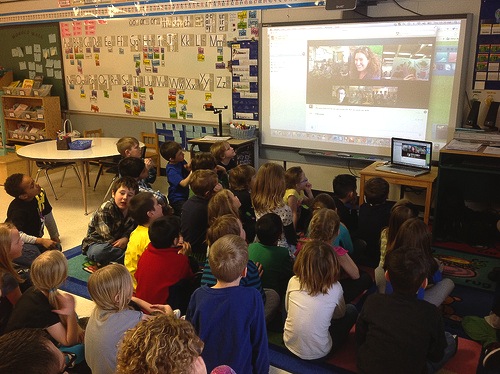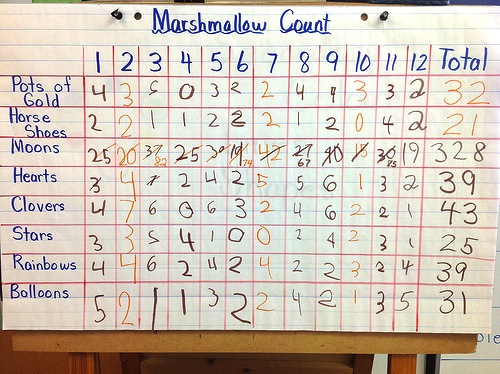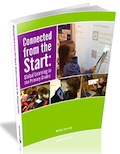
A couple of weeks ago, Skype announced they are now allowing educators free access to their group video calling. This would mean that in a call with multiple users, you would be able to see the video feed of all the participants. Previously, this feature had been restricted to premium users who pay for the service.
This sounded intriguing to me, so I went to my free Skype in the Classroom account and logged in to get the access code. I followed the instructions, waited 48 hours and voila! I had access to the service. The only thing left to do was to try it out. My primary students had learned so many things in past Skype calls. What would we be able to learn now?
With St. Patrick’s Day approaching, I had also signed up for Jennifer Wagner’s project to count the marshmallow shapes in a box of Lucky Charms.
 I knew that other teachers on Twitter had also signed up, so I tweeted to ask if anyone wanted to join my class and count live together via Skype. A kindergarten class from Winnipeg, a grade three class from northern Manitoba, a grade one class from Surrey and a grade two class in Regina all decided to join us. When I got to school the next day, the teacher next door to me wanted to be part of it as well, so that made six classes for our group video call!
I knew that other teachers on Twitter had also signed up, so I tweeted to ask if anyone wanted to join my class and count live together via Skype. A kindergarten class from Winnipeg, a grade three class from northern Manitoba, a grade one class from Surrey and a grade two class in Regina all decided to join us. When I got to school the next day, the teacher next door to me wanted to be part of it as well, so that made six classes for our group video call!
How did it go?
We planned to have a story, to count our Lucky Charms and to share our results via the group chat. One of the teachers also suggested that we could share our results using a Lino.it (which we did).
I have been using Skype fairly regularly for several years now. There are occasional hiccups, but we just hang up and try again. Five other classes instead of one other class meant five times as many chances for hiccups (and there were a few), but the class next door to me just came into our classroom instead (their video froze) and the one class that none of us could see could see almost all of us, so everyone was happy.
The counting took longer than anticipated, and several of the classes had to leave for various reasons. In the end, it was only my class and one other, so several of my students watched as they finished counting. In the end, we too ran out of time.
Fortunately, we were able to arrange a one to one Skype call with one of the classes the next day to compare our results. I know that other classes were able to work this out as well so that the opportunity for the students to share—the best part of the experience—could be maintained.

What did my students learn from this experience?
- Counting and Sorting Skills – My grade ones counted the various marshmallow shapes and my grade twos counted the regular shapes.
- Addition – The grade ones had to add each of their totals together to get a final count. This involved much higher numbers than they were used to using, but they used the strategies they had been practicing on numbers to twenty and were successful. The grade twos also used strategies they were practicing to help the grade ones and to add even larger numbers.
- Estimating – In the end, there were just too many regular cereal pieces for the grade twos to count, so they used the piles of one hundred they already had and estimated.
- Comparison – Comparing totals with the other classes.
- Other Students Far Away Learn the Same Skills We Do – This important notion cannot be over-emphasized. It gives much more credence to your learning when you see other children practicing the same skills.
- Sometimes Adults Problem Solve, Too – Again, it is valuable to learn that sometimes you need to try other solutions to a problem.
What did I learn?
- Skype is a great tool – And the opportunity for educators to use the group video feature at no cost is a valuable one.
- Planning is essential – In hindsight, we had planned far too many things for this call. Having many classes meant that people were not heard. A group call among three or more classrooms needs to be much better focused than a one-to-one call does.
The ability to have group calls has been available on Google+ for a while now, but I think many more teachers are comfortable using Skype as a tool than Google+. While our first experiment with this new free serve may have felt a bit overwhelming, we’ll definitely find great ways to take advantage of it. It will be a valuable addition to my connecting arsenal.
Skype on!

Kathy Cassidy is the author of Connected From the Start: Global Learning in the Primary Grades, which will be published in a highly interactive eBook format this month by Powerful Learning Press. Kathy’s book includes a full chapter on using Skype to connect students with experts and other classrooms around the world.
Kathy Cassidy
Latest posts by Kathy Cassidy (see all)
- Technology in the Classroom: Embrace the Bumpy Ride! - March 21, 2019
- Passion Based Learning (PBL) in Primary: Making Up the Rules - March 13, 2019
- Passion Based Learning (PBL) in the Primary Grades: Who Asks the Questions? - February 17, 2019

